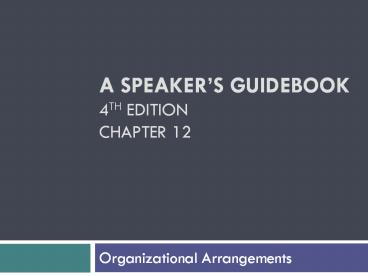A SPEAKER - PowerPoint PPT Presentation
Title:
A SPEAKER
Description:
A SPEAKER S GUIDEBOOK 4TH EDITION CHAPTER 12 Organizational Arrangements Informative Types of Arrangement Topical Chronological Spatial Causal (Cause-Effect ... – PowerPoint PPT presentation
Number of Views:73
Avg rating:3.0/5.0
Title: A SPEAKER
1
A SPEAKERS GUIDEBOOK4TH EDITIONCHAPTER 12
- Organizational Arrangements
2
Informative Types of Arrangement
- Topical
- Chronological
- Spatial
- Causal (Cause-Effect)
- Problem-Solution
- Narrative
- Circular
3
Imagine Arrangement Frames
Each of your three main ideas must be of the same
organizational pattern.
Each main idea has sub-points which do not have
to follow the same pattern as the main ideas as
long as they match each other.
4
Arrangement
- The strategic process of organizing speech points
into a coherent and convincing pattern for your
topic and your audience. - Outlining is the physical process of plotting
those speech points on the page in hierarchical
order of importance. - Your outline will give you a visual snapshot of
your speech organization and serve you better
than writing a manuscript or essay.
5
Topical Pattern of Arrangement
- Each main point is a subtopic or category of the
speech topic. - Some speech writers term this categorical design.
- Usually main ideas can go in any order in a
topical pattern however, careful consideration
of the order may help your audience understand
your speech more easily.
6
Chronological Pattern of Arrangement
- Follows a natural sequential order For example,
most people eat breakfast, lunch, then dinner. - Historical topics or supporting materials should
also follow a chronological pattern from most to
least past events, then current events, and then
predictions for the future. - Medically speaking, you are born, you live,
and then you die. - Follow the steps in a process
in sequential order.
7
Spatial Pattern of Arrangement
- Describes or explains the physical arrangement of
a place, a scene, or an object in order of
relationship to the other elements contained
wherein. - Pretend you are giving your audience a tour of
the Eiffel Tower do you begin the tour at the
top or at the bottom of the Tower?
8
Causal Pattern of Arrangement(Cause-Effect)
- Typically a causal pattern contains only two main
points first, the cause, and second, the effect. - However, you can have multiple causes for a
single effect, or a single cause with multiple
effects. - A few topics allow the speaker to reverse the
pattern and list the effect followed by the
cause.
For example In May 2007, the city
of Greensburg, Kansas was completely
destroyed by a F-5 Tornado.
9
Problem-Solution Pattern of Arrangement
- Organizes main points to show the nature or
significance of the problem and to provide
justification for the solution - An informative speech may explain the facts of a
solution that has been proposed by someone else. - A persuasive speech attempts to convince the
audience that the solution will work. - The simple design includes two main points
problem and solution. - The complex design breaks down the problem into
multiple points and provides solutions that have
been tried and failed, as well as, the new
proposed solution.
10
Narrative Pattern of Arrangement
- Speech is arranged like telling a familiar story
with characters, setting, and plot. - Most narratives follow another pattern of
arrangement, such as a chronological order of
events. - The stories told in the speech must illustrate
the theme of the speech topic.
11
Circular Pattern of Arrangement
- As each idea is developed by the speaker, it
leads into the next idea in a logical line of
reasoning. - The theory of the
Self-Fulfilling Prophecy
is one example of
a circular
pattern.
12
Question
- You want to give a speech showing how to reduce
your carbon footprint. What would be the best
pattern of arrangement? - A. Topical
- B. Causal
- C. Chronological
- D. Narrative
- E. Circular
13
Types of Persuasive Arrangement
- Monroes Motivational Sequence
- Refutation
- Comparative Advantage
- Persuasive types will be covered in detail in
Chapter 26.
14
Chapter 12 Key Terms for Review
- topical pattern of arrangement
- chronological pattern of arrangement
- spatial pattern of arrangement
- causal (cause-effect) pattern of arrangement
- problem-solution pattern of arrangement
- narrative pattern of arrangement
- circular pattern of arrangement































